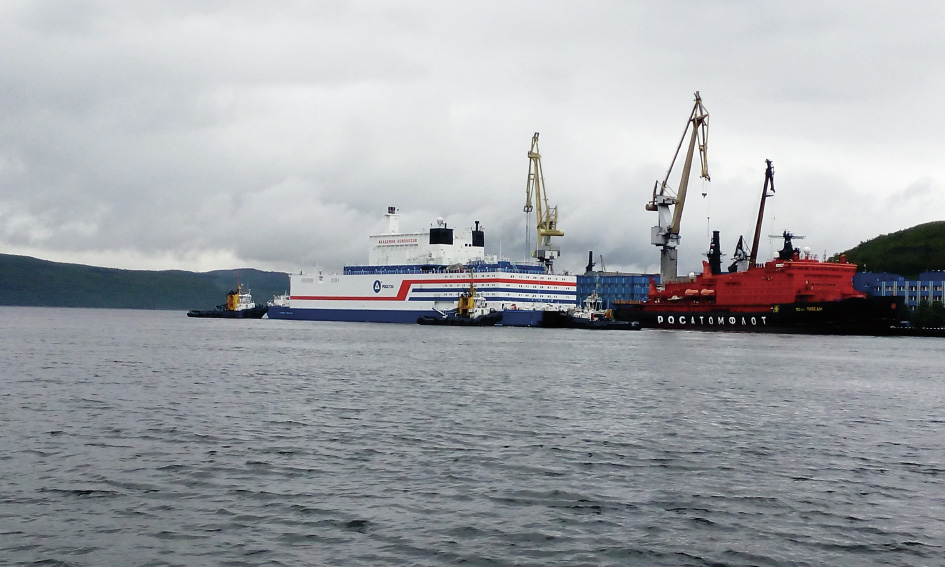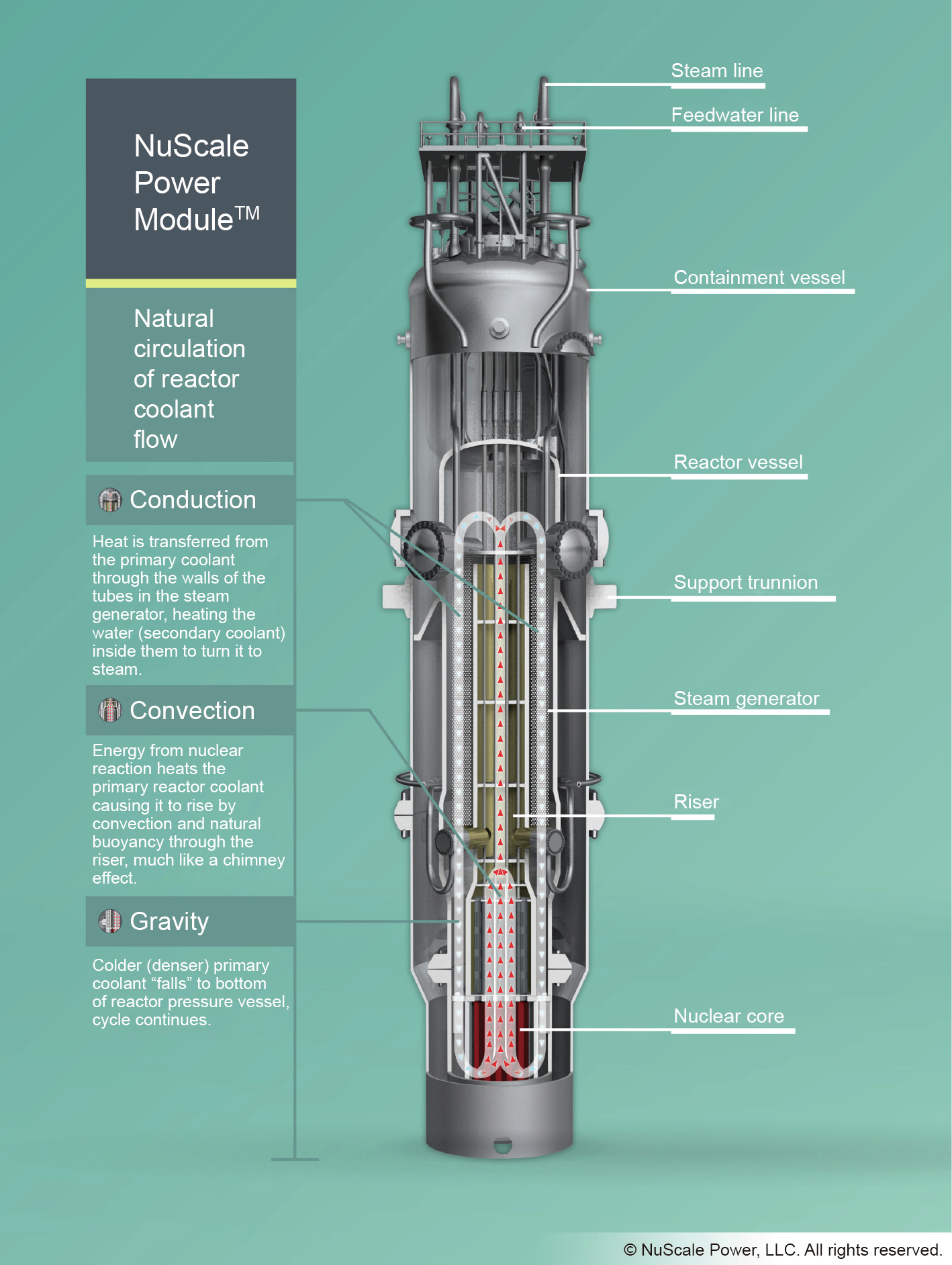On 9 September 2019, residents of Pevek in northeastern Siberia saw their new nuclear power plant sail into the harbor. Outfitted with two reactors, the 144 m long ship Akademik Lomonosov (Fig. 1) will provide up to 70 MW of electricity and 50 Gcal·h-1 (1 cal = 4.19002 J) of steam heat to homes and industries in the town and its surroundings [1].
《Fig. 1》

Fig. 1. On 23 August 2019, the first floating nuclear power station began its 4700 km journey from Murmansk in Russia to the port of Pevek, on the Eastern Siberia Sea, where it will be used to produce electricity for the region of Chukotka. The ship, capable of producing energy for a city of 100 000 inhabitants, will become the most northern nuclear facility in the world. The Akademik Lomonosov was built by the Baltic Shipyard in St. Petersburg and is owned by the Russian company Rosatom. Credit: Elena Dider, Wikimedia Commons (CC BY-SA 4.0).
Akademik Lomonosov is not just the world’s first floating nuclear power station. It is also the first in a new class of reactors known as small modular reactors (SMRs) to go into service. Although they generate less electricity than their bigger counterparts, SMRs might overcome some of the problems that have plagued full-sized reactors. Proponents say that they will be cheaper to build, more flexible, and safer, and that they could provide a much-needed boost to the nuclear industry [2].
Other countries are also pursuing SMRs. As soon as 2023, construction could begin in the United States at the Idaho National Laboratory (INL) in Idaho Falls on a plant that will ultimately contain a dozen of the reactors [3]. China is about to start building its own ship-borne SMR [4] and is developing land-based designs, including some for heating [5].
"SMRs could be a game-changer for the nuclear industry,” said Jacopo Buongiorno, professor of nuclear science and engineering at the Massachusetts Institute of Technology. But as he and other nuclear experts caution, these mini-reactors still need to show that they can reach their potential.
Today’s full-sized nuclear reactors typically generate around 1000 MW of energy. SMRs, in contrast, usually produce 300 MW or less. Scaled-down reactors have been around for decades—the United States built several in the 1950s and 1960s [6]. However, proponents of SMRs argue that they can now dramatically cut costs and improve safety by capitalizing on new technologies and construction approaches.
The soaring price tag for standard reactors is the main driver for development of SMRs in the United States and some other countries. A large-scale nuclear plant now requires about ten years to complete and costs an average of $10 billion USD, Buongiorno said. "There is a strong financial argument in favor of the smaller reactors,” he said.
One reason that SMRs could be cheaper to build is that, unlike large reactors that are usually tailor-made for a particular location, they will contain standard components that are manufactured in factories and shipped to the plant sites for assembly [7]. The savings from this pre-fabricated approach could be dramatic, say SMR advocates. For example, the 12 SMRs NuScale Power (Tigard, Oregon) plans to build at the INL location in Idaho will each produce up to 60 MW of electricity [8]. Together, the reactors will have the capacity of a large nuclear plant, but the company estimates the total cost of the project will be only $3 billion USD [9].
As their name indicates, SMRs are modular, which is another of their benefits. Like batteries in series, they can be linked to boost output, thus providing more flexibility in matching generating capacity to power demand. As need for electricity rises, utilities or countries can gradually add affordable small reactors rather than constructing a massive plant that requires a huge initial outlay. "You can build your capacity in smaller increments,” said Buongiorno.
The new generation of small reactors may also be safer. They produce less radiation overall, Buongiorno said. And their size allows them to use different strategies for controlling that radiation and for cooling the reactor core. Traditional reactors sit within a containment structure that helps prevent radiation release. For top-of-the-line AP1000 models, such as the two under construction at the Vogtle site in Georgia in the United States, this concrete and steel cap is 82 m high and 44 m wide [10]. In contrast, each of the NuScale reactors will fit into a steel case 25 m tall and 4.6 m wide that resembles a torpedo (Fig. 2). Because it is so much smaller than a standard containment structure, this design should be able to resist pressures that are 15 times greater [10].
《Fig. 2》

Fig. 2. The NuScale SMR design relies on passive water circulation to cool the core. As water in the core gets hotter, it becomes less dense and rises out of the core. This water transfers some of its heat to water for the steam generators and begins to cool, becoming denser and eventually sinking to the base of the core and starting the cycle over. Credit: NuScale, Wikimedia Commons (CC BY-SA 3.0).
For cooling, SMRs typically rely on passive mechanisms rather than the active systems that failed in the Three Mile Island and Fukushima accidents, causing nuclear fuel to overheat and melt. A tsunami knocked out the backup generators that powered the cooling pumps at Fukushima [11]. At Three Mile Island, a series of errors led the plant operators to shut down the pumps [12]. The NuScale reactors will not use pumps to circulate water through the core. Instead, they will create so-called natural circulation, in which the changing density of the water as its heats and cools causes it to cycle through the reactor core [13]. The NuScale reactors will also sit in a pool of water that helps control their temperature [10].
Along with smaller companies like NuScale, big ones such as Westinghouse, General Electric, and Rolls Royce are developing SMR designs. In the United States, the NuScale reactors at INL are the closest to starting construction. The company’s plans have now passed three of the five required design review stages at the US Nuclear Regulatory Commission (NRC) [14]. NuScale also has a contract with a consortium of utilities to buy the reactors’ electricity [15] and forecasts that the first unit will be operating by 2026. Other SMRs may be online soon as well. A land-based demonstration SMR in China could be up and running by 2025 [16], and the country’s ship-borne small reactor is scheduled to launch the same year [4].
The expectations for SMRs are high, and some skeptics doubt the reactors will measure up. They note, for example, that the small reactors the United States opened in the 1950s and 1960s suffered from serious safety problems and produced very expensive power [6]. Other critics question whether even today’s advanced SMRs will be able to compete when electricity generated by natural gas is so inexpensive and energy from renewable sources is becoming more affordable [17].
"Will they be economical? Nobody knows,” said Allison Macfarlane, professor of public policy and international affairs at the George Washington University and former chairman of the NRC. "Until you start building them, you have no idea.”
One thing that SMRs will not do, she said, is single-handedly revive the languishing US nuclear industry. Its problems stem from a variety of causes, including competition from natural gas and deregulation of power markets in the 1990s, she said. "It is not clear to me that SMRs will address all of these issues.”
Still, Buongiorno noted, small reactors could be more useful for countries such as United States, where traditional nuclear plants have become prohibitively expensive, than for countries such as Russia and China, where construction of those plants is still going strong. How well the NuScale reactors at INL perform will have a big impact on whether the United States builds more SMRs, he said. "They have to deliver what they promised,” he said. "If the cost overruns and delays of the recent past also occur for these early SMR projects, you will see frost building up on the concept of SMRs in the United States.”













 京公网安备 11010502051620号
京公网安备 11010502051620号




